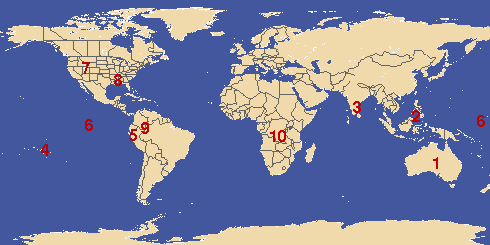
Along the equator, the western Pacific has some of the world's warmest ocean water, while in the eastern Pacific, cool water wells up, carrying nutrients that support large fish populations.
But, every two to seven years, strong westward-blowing trade winds subside, and warm water slowly moves back eastward across the Pacific, like water shifting in a giant bathtub. The warm water and shifting winds interrupt the upwelling of cool, nutrient-rich water. Fish die; climatic changes affect many parts of the world.
Peruvians named this phenomenon El Niño, for the Christ child, because it first appears around Christmas.
The most severe El Niño of the century occurred in the winter of 1982 and 1983. Disastrous effects and meteorological changes occurred around the world. Total damages were estimated at over $8 billion.

![]()
Judith Gradwohl, Smithsonian Institution (Curator/Ocean Planet)